Name Julius Evola | Role Philosopher | |
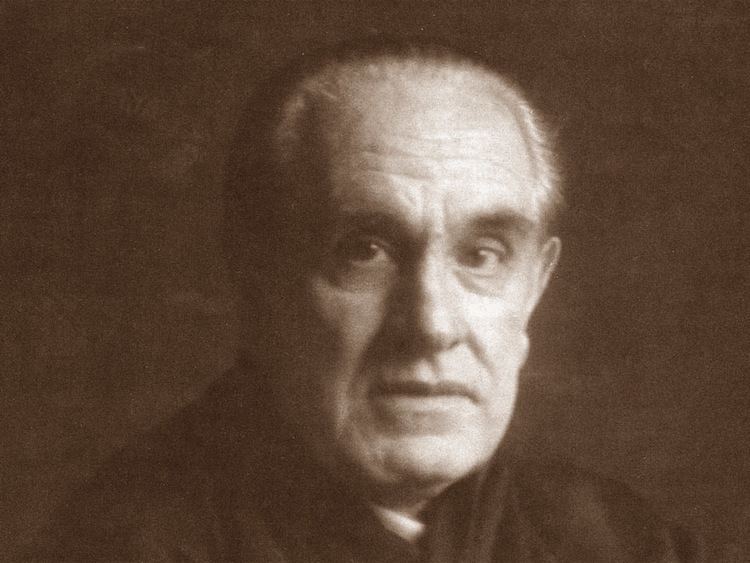 | ||
Full Name Giulio Cesare Andrea Evola Parents Vincenzo Evola, Concetta Mangiapane Books Revolt Against the Modern, Ride the Tiger, Eros and the Mysteries, Men Among the Ruins, The Hermetic Tradition Similar People Rene Guenon, Aleksandr Dugin, Alain de Benoist, Ernst Junger, Friedrich Nietzsche | ||
An Interview with Julius Evola
Julius Evola 朱利葉斯·埃佛拉 (1898-1974) Futurism Dada Italian
Baron Giulio Cesare Andrea Evola ([ˈɛːvola]; 19 May 1898 – 11 June 1974), better known as Julius Evola , was an Italian philosopher, painter, and esotericist. According to the scholar Franco Ferraresi, "Evola’s thought can be considered one of the most radical and consistent anti-egalitarian, anti-liberal, anti-democratic, and anti-popular systems in the twentieth century. It is a singular (though not necessarily original) blend of several schools and traditions, including German idealism, Eastern doctrines, traditionalism, and the all-embracing Weltanschauung of the interwar conservative Revolution with which Evola had a deep personal involvement."
Contents
- An Interview with Julius Evola
- Julius Evola 1898 1974 Futurism Dada Italian
- Early Years
- Pagan Imperialism
- Revolt Against the Modern World
- Mystery of the Grail
- Doctrine of Awakening
- Metaphysics of War
- American Civilization
- Ride the Tiger
- Occultism and Esoteriscm
- Magical Idealism
- Ur Group
- Misogyny and Sexual Magic
- Racism and Mystical Aryanism
- National Mysticism
- Antisemitism
- Fascism
- The Third Reich
- Post War
- Death
- Political Influence
- Books and articles
- References
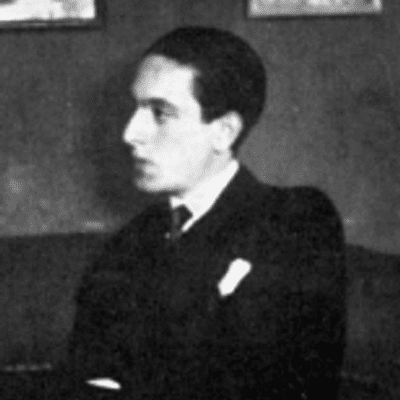
Historian Aaron Gillette described Evola as "one of the most influential fascist racists in Italian history." Evola was admired by the Italian Fascist leader Benito Mussolini. He idolized the Nazi Schutzstaffel ("SS"). He admired SS head Heinrich Himmler, whom he knew personally. Evola spent World War II working for the Nazi Sicherheitsdienst. During his trial in 1951, Evola denied being a Fascist and instead referred to himself as a "superfascist". Concerning this statement, historian Elisabetta Cassina Wolff wrote that "It is unclear whether this meant that Evola was placing himself above or beyond Fascism."
Evola was the "chief ideologue" of Italy's terrorist radical right after World War II. He continues to influence contemporary neo-fascist movements.
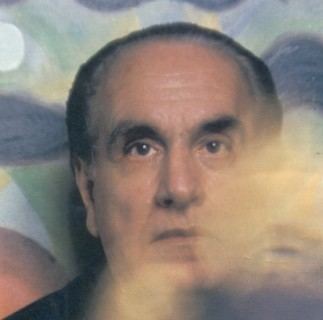
Many of Evola's theories and writings were centered on his idiosyncratic mysticism, occultism, and esoteric religious studies, and this aspect of his work has influenced occultists and esotericists. Evola also advocated domination and rape of women because he saw it "as a natural expression of male desire"; this misogynistic outlook stemmed from his extreme right views on gender roles, which demanded absolute submission from women.
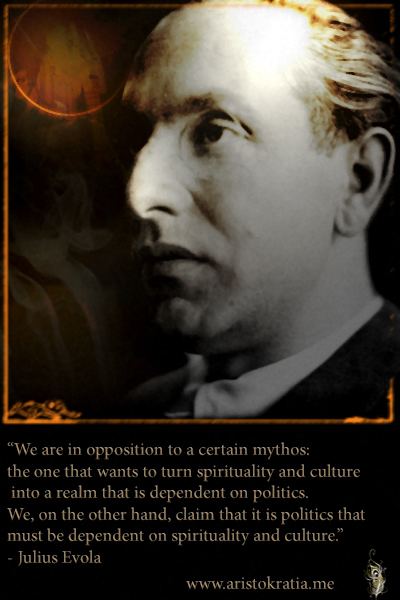
Early Years
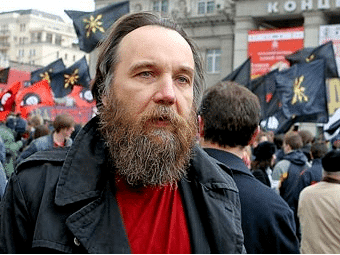
Giulio Cesare Andrea Evola was born in Rome to a minor aristocratic family of Sicilian origins. He was a baron. Little is known about his early upbringing except that he considered it irrelevant. Evola studied engineering in Rome, but did not complete his studies because he "did not want to be associated in any way with bourgeois academic recognition and titles such as doctor and engineer."
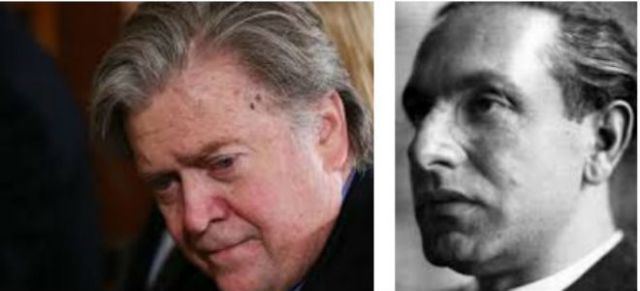
In his teenage years, Evola immersed himself in painting—which he considered one of his natural talents—and literature, including Oscar Wilde and Gabriele d'Annunzio. He was introduced to philosophers such as Nietzsche and Otto Weininger. Other early philosophical influences included Carlo Michelstaedter and Max Stirner.
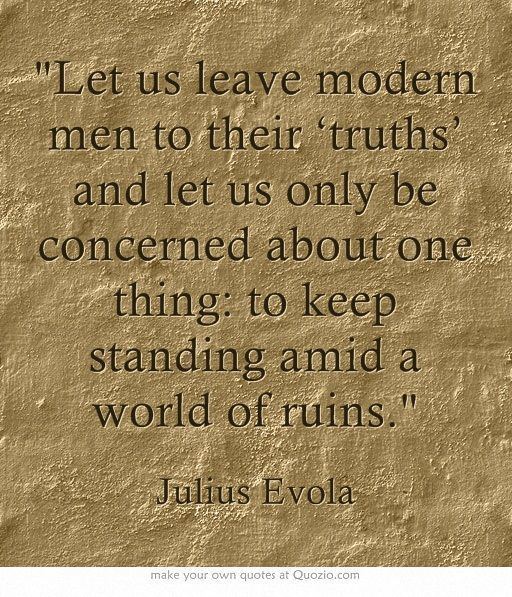
Evola served in World War I as an artillery officer on the Asiago plateau. He was attracted to the avant-garde and after the war, Evola briefly associated with Filippo Marinetti's Futurist movement. He became a prominent representative of Dadaism in Italy through his painting, poetry, and collaboration on the briefly published journal, Revue Bleu. In 1922, after concluding that avant-garde art was becoming commercialized and stiffened by academic conventions, he reduced his focus on artistic expression such as painting and poetry.
Pagan Imperialism
In 1928, Evola wrote a violent attack on Christianity titled Pagan Imperialism, which proposed transforming fascism into a system consonant with ancient Roman values and the ancient Mystery traditions. Evola proposed that fascism should be vehicle for reinstating the caste-system and aristocracy of antiquity. Although Evola invoked the term fascism in this text, his diatribe against the Catholic Church was criticized by both the fascist regime and the Vatican itself. A. James Gregor argued that the text was an attack on fascism as it stood at the time of writing, but noted that Benito Mussolini made use of it in order to threaten the Vatican with the possibility of an "anti-clerical fascism". On account of Evola's sentiment, the Vatican backed right-wing Catholic journal Revue Interlationale de Sociétés Secretètes published an article in April 1928 entitled "Un Sataniste Italien: Julius Evola."
Revolt Against the Modern World
Evola's Revolt Against the Modern World is a text that promotes the mythology of an ancient Golden Age. In this work, Evola attempted to describe the features of his idealized traditional society. Evola argued that modernity represented a serious decline from an ideal society. He argued in that in the postulated Golden age, religious and temporal power were united. He wrote that society had not been founded on priestly rule, but by warriors expressing spiritual power. In mythology, he saw evidence of the West's superiority over the East. Moreover, he claimed that the traditional elite had the ability to access power and knowledge through a hierarchical version of magic which differed from the lower "superstitious and fraudulent" forms of magic. Evola insists on "nonmodern forms, institutions, and knowledge" as being necessary to produce a "real renewal ... in those who are still capable of receiving it." The text was "immediately recognized by Mircea Eliade and other intellectuals who allegedly advanced ideas associated with Tradition." Mircea Eliade, one of Evola's closest friends, was a fascist sympathizer associated with the Romanian fascist Iron Guard. Evola was aware of the importance of myth from his readings of Georges Sorel, one of the key intellectual influences on fascism. Herman Hesse described Revolt Against the Modern World as "really dangerous."
Mystery of the Grail
Evola's text The Mystery of the Grail discarded Christian interpretations of the Holy Grail. Evola wrote that the Grail "symbolizes the principle of an immortalizing and transcendent force connected to the primordial state...The mystery of the Grail is a mystery of a warrior initiation." He held that the Ghibellines, who fought the Guelph for control of Northern and central Italy in the thirteenth century, had within them the residual influences of pre-Christian Celtic and Nordic traditions that represented his conception of the Grail myth. He also held that the Guelph victory against the Ghibellines represented a regression of the castes, since the merchant caste took over from the warrior caste. In the epilogue to this text Evola argued that the Protocols of Zion, regardless of whether it was authentic or not, was a cogent representation of modernity. Historian Richard Barber said: "Evola mixes rhetoric, prejudice, scholarship, and politics into a strange version of the present and future, but in the process he brings together for the first time interest in the esoteric and in conspiracy theory which characterize much of the later Grail literature."
Doctrine of Awakening
In The Doctrine of Awakening, Evola argued that the Pāli Canon could be held to represent true Buddhism. His interpretation of Buddhism is that it was intended to be anti-democratic. He believed that Buddhism revealed the essence of an "Aryan" tradition that had become corrupted and lost in the West. He believed it coud be interpreted to reveal the superiority of a warrior caste. Harry Oldmeadow described Evola's work on Buddhism as exhibiting Nietzschean influence, but Evola criticized Nietzsche's anti-ascetic prejudice. The book "received the official approbation of the Pāli [text] society", and was published by a reputable Orientalist publisher. Evola's interpretation of Buddhism, as put forth in his article "Spiritual Virility in Buddhism", is in conflict with the post-WWII scholarship of the Orientalist Giuseppe Tucci, which argues that the viewpoint that Buddhism advocates universal benevolence is legitimate. Arthur Versluis stated that Evola's writing on Buddhism was a vehicle for his own theories, but was a far from accurate rendition of the subject, and he held that much the same could be said of Evola's writing on Hermeticism. Nanavira Thera was inspired to become a bhikkhu from reading Evola's text The Doctrine of Awakening in 1945 while hospitalized in Sorrento.
Metaphysics of War
In the posthumously published collection of writings, Metaphysics of War, Evola, in line with the Conservative Revolutionary Ernst Jünger, explored the viewpoint that war could be a spiritually fulfilling experience. He proposed the necessity of a transcendental orientation in a warrior.
American "Civilization"
Nicholas Goodrick-Clarke has written that Evola's 1945 essay "American 'Civilization'" described America as "the final stage of European decline into the 'interior formlessness' of vacuous individualism, conformity and vulgarity under the universal aegis of money-making." According to Goodrick-Clarke, Evola argued that America's "mechanistic and rational philosophy of progress combined with a mundane horizon of prosperity to transform the world into an enormous suburban shopping mall."
Ride the Tiger
EC Wolff noted that in Ride the Tiger "Evola argued that the fight against modernity was lost. The only thing a ‘real man’ could just do was to ride the tiger of modernity patiently". Evola wrote that the events of the period would have to run their course but he "did not exclude the possibility of action in the future." He argued that one should be ready to intervene when the tiger "is tired of running." Nicholas Goodrick-Clarke notes that, "Evola sets up the ideal of the “active nihilist” who is prepared to act with violence against modern decadence." According to European Studies professor Paul Furlong, this text presents Evola's view that the potential "elite" should immunize itself from modernity and use "right wing anarchism" to rebel against it.
Occultism and Esoteriscm
Around 1920, Evola's interests led him into spiritual, transcendental, and "supra-rational" studies. He began reading various esoteric texts and gradually delved deeper into the occult, alchemy, magic, and Oriental studies, particularly Tibetan Lamaism and Vajrayanist Tantric yoga. A keen mountaineer, Evola described the experience as a source of revelatory spiritual experiences. After his return from the war, Evola experimented with hallucinogenic drugs and magic.
When he was about 23 years old, Evola considered suicide. He claimed that he avoided suicide thanks to a revelation he had while reading an early Buddhist text that dealt with shedding all forms of identity other than absolute transcendence. Evola would later publish the text The Doctrine of Awakening, which he regarded as a repayment of his debt to the doctrine of Buddha for saving him from suicide.
Evola wrote prodigiously on Eastern mysticism, Tantra, hermeticism, the myth of the holy grail and western esotericism. German Egyptologist and esoteric scholar Florian Ebeling has noted that Evola's The Hermetic Tradition is viewed as an "extremely important work on Hermeticism" in the eyes of esotericists. Evola gave particular focus to Cesare della Riviera's text Il Mondo Magico degli Heroi, which he later republished in modern Italian. He held that Riviera's text was consonant with the goals of "high magic" – the reshaping of the earthly human into a transcendental 'god man'. According to Evola, the alleged "timeless" Traditional science was able to come to lucid expression through this text, in spite of the "coverings" added to it to prevent accusations from the church. Though Evola rejected Carl Jung's interpretation of alchemy, Jung described Evola's The Hermetic Tradition as a "magisterial account of Hermetic philosophy". In Hegel and the Hermetic Tradition, the philosopher Glenn Alexander Magee favored Evola's interpretation over that of Jung's. In 1988, a journal devoted to Hermetic thought published a section of Evola's book and described it as "Luciferian."
Evola later confessed that he was not a Buddhist, and that his text on Buddhism was meant to balance his earlier work on the Hindu tantras. Evola's interest in tantra was spurred on by correspondence with Sir John Woodroffe. Evola was attracted to the active aspect of tantra, and its claim to provide a practical means to spiritual experience, over the more "passive" approaches in other forms of Eastern spirituality. In Tantric Buddhism in East Asia, Richard K. Payne, Dean of the Institute of Buddhist Studies, argued that Evola manipulated Tantra in the service of right wing violence, and that the emphasis on "power" in The Yoga of Power gave insight into his mentality.
Evola advocated that "differentiated individuals" following the Left-Hand Path use dark violent sexual powers against the modern world. For Evola, these "virile heroes" are both generous and cruel, possess the ability to rule, and commit "Dionysian" acts that might be seen as conventionally immoral. For Evola, the Left Hand path embraces violence as a means of transgression.
According to A. James Gregor Evola's definition of spirituality can be found in Meditations on the Peaks: "what has been successfully actualized and translated into a sense of superiority which is experienced inside by the soul, and a noble demeanor, which is expressed in the body." Nicholas Goodrick-Clarke wrote that Evola's "rigorous New Age spirituality speaks directly to those who reject absolutely the leveling world of democracy, capitalism, multi-racialism and technology at the outset of the twenty-first century. Their acute sense of cultural chaos can find powerful relief in his ideal of total renewal." Thomas Sheehan wrote that to "read Evola is to take a trip through a weird and fascinating jungle of ancient mythologies, pseudo-ethnology, and transcendental mysticism that is enough to make any southern California consciousness-tripper feel quite at home."
Magical Idealism
Thomas Sheehan wrote that "Evola's first philosophical works from the 'twenties were dedicated to reshaping neo-idealism from a philosophy of Absolute Spirit and mind into a philosophy of the "absolute individual" and action." Accordingly, Evola developed the doctrine of "magical idealism", which held that "the Ego must understand that everything that seems to have a reality independent of it is nothing but an illusion, caused by its own deficiency." For Evola, this ever-increasing unity with the "absolute individual" was consistent with unconstrained liberty, and therefore unconditional power. In his 1925 work Essays on Magical Idealism, Evola declared that "God does not exist. The Ego must create him by making itself divine."
According to Sheehan, Evola discovered the power of metaphysical mythology while developing his theories. This led to his advocacy of supra-rational intellectual intuition over discursive knowledge. In Evola's view, discursive knowledge separates man from Being. Sheehan stated that this position is a theme in certain interpretations of Western philosophers such as Plato, Thomas Aquinas, and Martin Heidegger that was exaggerated by Evola. Evola would later write:
The truths that allow us to understand the world of Tradition are not those that can be "learned" or "discussed." They either are or are not. We can only remember them, and that happens when we are freed from the obstacles represented by various human constructions (chief among these are the results and methods of the authorized "researchers") and have awakened the capacity to see from the nonhuman viewpoint, which is the same as the Traditional viewpoint ... Traditional truths have always been held to be essentially non-human.
Evola developed a doctrine of the "two natures": the natural world and the primordial "world of 'Being'". He believed that these "two natures" impose form and quality on lower matter and create a hierarchical "great chain of Being." He understood "spiritual virility" as signifying orientation towards this postulated transcendent principle. He held that the State should reflect this "ordering from above" and the consequent hierarchical differentiation of individuals according to their "organic preformation". By "organic preformation" he meant that which "gathers, preserves, and refines one's talents and qualifications for determinate functions."
Ur-Group
Evola was introduced to esotericism by Arturo Reghini, who was an early supporter of fascism. Reghini sought to promote a "cultured magic" opposed to Christianity and introduced Evola to the traditionalist René Guénon. In 1927, Reghini and Evola, along with other Italian esotericists, founded the Gruppo di Ur (the Ur Group). The purpose of this group was to attempt to bring the members' individual identities into such a superhuman state of power and awareness that they would be able to exert a magical influence on the world. The group employed techniques from Buddhist, Tantric, and rare Hermetic texts. They aimed to provide a "soul" to the burgeoning Fascist movement of the time through the revival of ancient Roman Paganism, and to influence the fascist regime through esotericism.
Articles on occultism from the Ur Group were later published in Introduction to Magic. Reghini's support of Freemasonry would however prove a bone of contention for Evola; accordingly, Evola broke with Reghini in 1928. Reghini himself broke from Evola, accusing Evola of plagiarizing his thoughts in the book Pagan Imperialism. Evola on the other hand blamed Reghini for the premature publication of Pagan Imperialism. Evola's later work owed a considerable debt to René Guénon's text Crisis of the Modern World, though he diverged from Guénon on the issue of the relationship between warriors and priests.
Misogyny and Sexual Magic
Julius Evola believed that the alleged higher qualities expected of a man of a particular race were not those expected of a woman of the same race. He held that "just relations between the sexes" involved women acknowledging their "inequality" with men. In 1925, he wrote an article titled "La donna come cosa" (Woman as Thing). Evola later quoted Joseph de Maistre's statement that "Woman cannot be superior except as woman, but from the moment in which she desires to emulate man she is nothing but a monkey." Evola believed that women's liberation was "the renunciation by woman of her right to be a woman". He held that a woman "could traditionally participate in the sacred hierarchical order only in a mediated fashion through her relationship with a man." He held, as a feature of his idealized gender relations, the Hindu sati, which for him was a form of sacrifice indicating women's respect for patriarchal traditions. He held that for the "pure, feminine" woman, "man is not perceived by her as a mere husband or lover, but as her lord." Evola believed that women would find "true greatness" in "total subjugation to men."
Evola regarded matriarchy and goddess religions as a symptom of decadence, and preferred a hyper-masculine, warrior ethos.
Evola was influenced by Hans Blüher; he was a proponent of the Männerbund concept as a model for his proposed ultra-fascist "Order." Nicholas Goodrick-Clarke noted the fundamental influence of Otto Weininger's misogynist book Sex and Character on Evola's dualism of male-female spirituality. According to Goodrich-Clarke, "Evola's celebration of virile spirituality was rooted in Weininger's work, which was widely translated by the end of the First World War." Unlike Weininger, Evola believed that women needed to be conquered, not ignored. Evola denounced homosexuality as "useless" for his purposes. He did not neglect sadomasochism, so long as sadism and masochism "are magnifications of an element potentially present in the deepest essence of eros." Then, it would be possible to "extend, in a transcendental and perhaps ecstatic way, the possibilities of sex."
Evola held that women "played" with men, threatened their masculinity, and lured them into a "constrictive" grasp with their sexuality. He wrote that "It should not be expected of women that they return to what they really are ... when men themselves retain only the semblance of true virility", and lamented that "men instead of being in control of sex are controlled by it and wander about like drunkards". He believed that in Tantra and in sexual magic, in which he saw a strategy for aggression, he found the means to counter the "emasculated" West. According to Annalisa Merelli, Evola "went so far as to justify rape" because he saw it "as a natural expression of male desire". Evola also said that the "ritual violation of virgins", and "whipping women" were a means of "consciousness raising", so long as these practices were done to the intensity required to produce the proper "liminal psychic climate". He wrote that "as a rule, nothing stirs a man more than feeling the woman utterly exhausted beneath his own hostile rapture."
Evola translated Weininger's Sex and Character into Italian. Dissatisfied with simply translating Weininger's work, he wrote the text Eros and the Mysteries of Love: The Metaphysics of Sex, where his views on sexuality were dealt with at length. Arthur Versluis described this text as Evola's "most interesting" work aside from Revolt Against the Modern World. This book remains popular among many New Age adherents.
Racism and Mystical Aryanism
Evola's dissent from standard biological concepts of race had roots in his aristocratic elitism, since Nazi Völkisch ideology inadequately separated aristocracy from "commoners." According to Furlong, Evola developed "the law of the regression of castes" in Revolt Against the Modern World and other writings on racism from the 1930s and World War II period. In Evola's view "power and civilization have progressed from one to another of the four castes—sacred leaders, warrior nobility, bourgeoisie (economy, 'merchants') and slaves" Furlong explains: "for Evola, the core of racial superiority lay in the spiritual qualities of the higher castes, which expressed themselves in physical as well as in cultural features, but were not determined by them. The law of the regression of castes places racism at the core of Evola's philosophy, since he sees an increasing predominance of lower races as directly expressed through modern mass democracies."
Prior to the end of War, Evola had frquently used the term "Aryan" to mean the nobility, who in his view were imbued with traditional spirituality. Wolff notes that Evola seems to have stopped writing about race in 1945, but adds that the intellectual themes of Evola's writings were otherwise unchanged. Evola continued to write about elitism and his contempt for the weak. His "doctrine of the Aryan-Roman 'super-race was simply restated as a doctrine of the 'leaders of men'...no longer with reference to the SS, but to the mediaeval Teutonic knights of the Knights Templar, already mentioned in Rivolta."
Evola spoke of "inferior non-European races". Peter Merkl wrote that "Evola was never prepared to discount the value of blood altogether". Evola wrote: "a certain balanced consciousness and dignity of race can be considered healthy" in a time where "the exaltation of the negro and all the rest, anticolonialist psychosis and integrationist fanatiscm [are] all parallel phenomena in the decline of Europe and the West." While not totally against race-mixing, in 1957, Evola wrote an article attributing the perceived acceleration of American decadence to the influence of "negroes" and the opposition to segregation. Furlong noted that this article is "among the most extreme in phraseology of any he wrote, and exhibits a degree of intolerance that leaves no doubt as to his deep prejudice against black people."
National Mysticism
For his spiritual interpretation of the different racial psychologies, Evola found the work of German race theorist Ludwig Ferdinand Clauss invaluable. Like Evola, Clauss believed that physical race and spiritual race could diverge as a consequence of miscegenation. Evola's racism included racism of the body, soul and spirit, giving primacy to the latter factor, writing that "races only declined when their spirit failed."
Like René Guénon, Evola believed that mankind is living in the Kali Yuga of the Hindu tradition—the Dark Age of unleashed, materialistic appetites. He argued that both Italian fascism and Nazism represented hope that the "celestial" Aryan race would be reconstituted. He drew on mythological accounts of super-races and their decline, particularly the hyperboreans, and maintained that traces of hyperborean influence could be felt in Indo-European man. He felt that Indo-European men had devolved from these higher mythological races. Gregor noted that several contemporary criticisms of Evola's theory were published : "In one of Fascism’s most important theoretical journals, Evola’s critic pointed out that many Nordic-Aryans, not to speak of Mediterranean Aryans, fail to demonstrate any Hyperborean properties. Instead, they make obvious their materialism, their sensuality, their indifference to loyalty and sacrifice, together with their consuming greed. How do they differ from 'inferior' races, and why should anyone wish, in any way, to favor them?"
Concerning the relationship between "spiritual racism" and biological racism, Evola put forth the following viewpoint, which Furlong described as pseudo-scientific: "The factor of 'blood' or 'race' has its importance, because it is not psychologically—in the brain or the opinions of the individual—but in the very deepest forces of life that traditions live and act as typical formative energies. Blood registers the effects of this action, and indeed offers, through heredity, a matter that is already refined and pre-formed..."
Antisemitism
Evola endorsed Otto Weininger's views on the Jews. Though Evola viewed Jews as corrosive and anti-traditional, he described Adolf Hitler's more fanatical anti-Semitism as a paranoid idée fixe that damaged the reputation of the Third Reich. Evola's conception did not emphasize the Nazi racial conception of Jews as "representatives of a biological race"—in Evola's view the Jews were "the carriers of a world view...a spirit [that] corresponded to the 'worst' and 'most decadent' features of modernity: democracy, egalitarianism and materialism."
Evola argued that The Protocols of Zion—whether or not a forgery—accurately reflect the conditions of modernity. He believed that the Protocols "contain the plan for an occult war, whose objective is the utter destruction, in the non-Jewish peoples, of all tradition, class, aristocracy, and hierarchy, and of all moral, religious, and spiritual values." He wrote the foreword to the second Italian edition of the Protocols, which was published by the Fascist Giovanni Preziosi in 1938.
Following the murder of his friend Corneliu Codreanu, the leader of the Fascist Romanian Iron Guard, Evola expressed anticipation of a "talmudic, Israelite tyranny." However, Evola believed that Jews had this "power" only because of European "decadence" in modernity. He also believed that one could be "Aryan", but have a "Jewish" soul, just as one could be "Jewish", but have an "Aryan" soul. In Evola's view Otto Weininger and Carlo Michelstaedter were Jews of "sufficiently heroic, ascetic, and sacral" character to fit the latter category.
Fascism
Evola has been described as "one of the most influential fascist racists in Italian history." Benito Mussolini read Evola's Synthesis of the Doctrine of Race (Sintesi di Dottrina della Razza) in August 1941, and met with Evola to offer him his praise. Evola later recounted that Mussolini had found in his work a uniquely Roman form of Fascist racism distinct from that found in Nazi Germany. With Mussolini's backing, Evola launched the minor journal Sangue e Spirito (Blood and Spirit). While not always in agreement with German racial theorists, Evola traveled to Germany in February 1942 and obtained support for German collaboration on Sangue e Spirito from "key figures in the German racial hierarchy." Fascists appreciated the palingenetic value of Evola's "proof" "that the true representatives of the state and the culture of ancient Rome were people of the Nordic race." Evola eventually became Italy's leading racial philosopher. He has been described as a "fascist intellectual," a "radical traditionalist," "antiegalitarian, antiliberal, antidemocratic, and antipopular,” and as having been "the leading philosopher of Europe's neofascist movement."
Julius Evola wrote for fascist journals, and his racial theories received warm reception from Mussolini in 1941. Yet, while acknowledging Evola's place among fascist intellectuals, his racism, his anti-semitism and his antipathy towards democracy, A James Gregor wrote that "Evola opposed literally every feature of Fascism".
Evola developed a complex line of argument, closely related to the spiritual orientation of Traditionalist writers such as René Guénon and the political concerns of the European Authoritarian Right. Evola's first published political work was an anti-fascist piece in 1925. In this work, Evola called Italy's fascist movement a "laughable revolution," based on empty sentiment and materialistic concerns. He applauded Mussolini's anti-bourgeois orientation and his goal of making Italian citizens into hardened warriors, but criticized Fascist populism, party politics, and elements of leftism that he saw in the fascist regime. Evola saw Mussolini's Fascist Party as possessing no cultural or spiritual foundation. He was passionate about infusing it with these elements in order to make it suitable for his ideal conception of Übermensch culture which, in Evola's view, characterized the imperial grandeur of pre-Christian Europe. He expressed anti-nationalist sentiment, stating that to become “truly human,” one would have to “overcome brotherly contamination” and “purge oneself” of the feeling that one is united with others “because of blood, affections, country or human destiny.” He also opposed the futurism that Italian fascism was aligned with, along with the "plebeian" nature of the movement. Accordingly, Evola launched the journal La Torre (The Tower), to voice his concerns and advocate for a more elitist fascism. Evola's ideas were poorly received by the fascist mainstream as it stood at the time of his writing.
In May, 1951, Evola was arrested and charged with promoting the revival of the Fascist Party, and of glorifying Fascism. Defending himself at trial, Evola stated that his work belonged to a long tradition of anti-democratic writers who certainly could be linked to fascism—at least fascism interpreted according to certain Evolian criteria—but who certainly could not be identified with the Fascist regime under Mussolini. Evola then declared that he was not a Fascist but a ‘superfascist’. He was acquitted.
The Third Reich
Finding Italian fascism too compromising, Evola began to seek recognition in the Third Reich. Evola spent a considerable amount of time in Germany in 1937 and 1938, and gave a series of lectures to the German–Italian Society 1938. Evola took issue with Nazi populism and biological materialism. SS authorities initially rejected Evola's ideas as supranational and aristocratic though he was better received by members of the Conservative Revolutionary movement. The Nazi Ahnenerbe reported that many considered his ideas to be pure “fantasy” which ignored “historical facts.”. Evola admired Heinrich Himmler, whom he knew personally, but he had reservations about Adolf Hitler because of Hitler's reliance on Völkisch nationalism.Himmler's SS kept a dossier on Evola—dossier document AR-126 described his plans for a "Roman-Germanic Imperium" as "utopian" and described him as a "reactionary Roman," whose goal was an "insurrection of the old aristocracy against the modern world." The document recommended that the SS "stop his effectiveness in Germany" and provide him with no support, particularly because of his desire to create a "secret international order".
Despite this opposition, Evola was able to establish political connections with pan-Europeanist elements inside the Reich Main Security Office. Evola subsequently ascended to the inner circles of Nazism as the influence of pan-European advocates overtook that of Völkisch proponents, due to military contingencies. Evola wrote the article Reich and Imperium as Elements in the New European Order for the Nazi-backed journal European Review. He spent World War II working for the SD. The SD bureau Amt VII, a Reich Main Security Office research library, helped Evola acquire arcane occult and Masonic texts.
Italian Fascism went into decline when, in 1943, Mussolini was deposed and imprisoned. At this point, Evola fled to Germany with the help of the SD. Although not a member of the Fascist Party, and despite his apparent problems with the Fascist regime, Evola was one of the first people to greet Mussolini when the latter was broken out of prison by Otto Skorzeny in 1943. Subsequently, Evola helped welcome Mussolini to Adolf Hitler's Wolf's Lair. Following this, Evola involved himself in Mussolini's Italian Social Republic. It was Evola's custom to walk around the city during bombing raids in order to better 'ponder his destiny'. During one such raid, 1945, a shell fragment damaged his spinal cord and he became paralyzed from the waist down, remaining so for the remainder of his life.
Post-War
After World War II, Evola continued his work in esotericism. He wrote a number of books and articles on sexual magic and various other esoteric studies, including The Yoga of Power: Tantra, Shakti, and the Secret Way (1949), Eros and the Mysteries of Love: The Metaphysics of Sex (1958), and Meditations on the Peaks: Mountain Climbing as Metaphor for the Spiritual Quest (1974). He also wrote his two explicitly political books Men Among the Ruins: Post-War Reflections of a Radical Traditionalist (1953), Ride the Tiger: A Survival Manual for the Aristocrats of the Soul (1961), and his autobiography, The Path of Cinnabar (1963). He also expanded upon critiques of American civilization and materialism, as well as increasing American influence in Europe, collected in the posthumous anthology Civilta Americana.
Evola's occult ontology exerted influence over post-war neo-fascism. In the post-war period, Evola's writing evoked interest among the neo-fascist right. After 1945, Evola was considered the most important Italian theoretician of the Conservative Revolution and the "chief ideologue" of Italy's post-war radical right. According to Egil Asprem and Kennet Granholm, Evola's most significant post-war political texts are Orientamenti and Men Among the Ruins.
Orientamenti was a text against "national fascism"—instead, it advocated for a European Community modeled on the principles of the Waffen-SS. The Italian Neo-fascist group Ordine Nuovo adopted Orientamenti as a guide for action in postwar Italy. The European Liberation Front, who were affiliated with Francis Parker Yockey, called Evola "Italy's gretest living authoriation philosopher" in the April 1951 issue of their publication Frontfighter
During the post-war period, Evola attempted to dissociate himself from totalitarianism, preferring the concept of the "organic" state, which he put forth in his text Men Among the Ruins. Evola sought to develop a strategy for the implementation of a "conservative revolution" in post World War II Europe. He rejected nationalism, advocating instead for a European Imperium, which could take various forms according to local conditions, but should be "organic, hierarchical, anti-democratic, and anti-individual." Evola endorsed Francis Parker Yockey's neo-fascist manifesto Imperium, but disagreed with it because he believed that Yockey had a "superficial" understanding of what was immediately possible. Evola believed that his conception of neo-fascist Europe could best be implemented by an elite of "superior" men who operated outside normal politics.
Giuliano Salierni was an activist in the neo-Fascist Italian Social Movement during the early 1950s. He later recalled Evola's calls to violence. Roberto Fiore and his colleagues in the early 1980s helped the National Front's "Political Soldiers" forge a militant elitist philosophy based on Evola's "most militant tract", The Aryan Doctrine of Battle and Victory.The Aryan Doctrine called for a “Great Holy War” that would be fought for spiritual renewal and fought in parallel to the physical “Little Holy War” against perceived enemies. Wolff attributes extreme-right terrorist actions in Italy in the 1970s and 1980s to the influence of Julius Evola.
Thomas Sheehan has argued that Evola's work is essential reading for those seeking to understand Eurofascism, in the same way that knowledge of the writings of Marx is necessary for those seeking to understand Communist actions.
Death
Evola died unmarried, without children, on 11 June 1974 in Rome.
Political Influence
The Italian Fascist leader Benito Mussolini, the Nazi Grail seeker Otto Rahn, and the Romanian fascist sympathizer and religious historian Mircea Eliade admired Julius Evola. After World War II, Evola's writings continued to influence many European far-right political, racist and neo-fascist movements. He is widely translated in French, Spanish and partly in German. Amongst those he has influenced are the American Blackshirts Party, the "esoteric Hitlerist" Miguel Serrano, Savitri Devi, GRECE, the Movimento sociale italiano (MSI), Falange Española, Gaston Armand Amaudruz's Nouvel Ordre Européen, Guillaume Faye, Pino Rauti's Ordine Nuovo, Troy Southgate, Alain de Benoist, Michael Moynihan, Giorgio Freda, the Nuclei Armati Rivoluzionari (Armed Revolutionary Nuclei), Eduard Limonov, Forza Nuova, CasaPound Italia, Tricolor Flame and the Conservative People's Party of Estonia. Giorgio Almirante referred to him as "our Marcuse—only better." According to one leader of the neofascist "black terrorist" Ordine Nuovo, "Our work since 1953 has been to transpose Evola’s teachings into direct political action." The now defunct French fascist group Troisième Voie was also inspired by Evola. Jonathan Bowden, English political activist and chairman of the New Right, spoke highly of Evola and his ideas and gave lectures on his philosophy.
Evola has also influenced today's Alt-right movement, which has its "origins" in “thinkers as diverse as… Oswald Spengler, H.L Mencken, Julius Evola, Sam Francis, and… Pat Buchanan.” Additionally, Evola has influenced Vladimir Putin advisor Aleksander Dugin. The Greek neo-Nazi party Golden Dawn includes his works on its suggested reading list, and the leader of Jobbik, the Hungarian nationalist party, admires Evola and wrote an introduction to his works. Umberto Eco referred to Evola as the "most influential theoretical source of the theories of the new Italian right", and as "one of the most respected fascist gurus".
President Donald Trump's former chief adviser Steve Bannon noted Evola's influence on the Eurasianism movement; accordingly, he has been praised by Alt-right leader Richard B. Spencer, who said “it means a tremendous amount” that Bannon is aware of Evola. Some members of the Alt-right have expressed hope that Bannon might be open to Evola's ideas, and that through Bannon, Evola’s ideas can express influence in a possible period of crisis.
